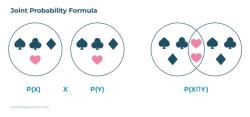How is probability used in real life situations?
Probability is widely used in various real-life situations to make informed decisions, assess risks, and understand uncertainty. Here are some common real-life applications of probability:
Weather Forecasting: Meteorologists use probability models to predict weather conditions. For example, they might say there's a 70% chance of rain tomorrow, which is based on historical data and current weather patterns.
Insurance: Insurance companies use probability to calculate premiums and assess risk. They analyze data to determine the likelihood of certain events, such as accidents or natural disasters, and set insurance rates accordingly.
Gambling and Casinos: Probability plays a central role in games of chance, like poker, roulette, and slot machines. Casinos use probability to ensure that their games are profitable while still offering the possibility of winning for players.
Healthcare and Medicine: Probability is used in medical research and diagnostics. It helps determine the likelihood of a disease occurring in a population, assess the effectiveness of treatments, and predict patient outcomes.
Finance and Investment: Investors and financial analysts use probability models to make investment decisions. They assess the likelihood of different financial outcomes and manage risk in portfolios.
Quality Control and Manufacturing: Manufacturers use probability to monitor product quality. Statistical process control techniques assess the probability of defects and help improve production processes.
Sports and Gambling: Sports analysts and bookmakers use probability to predict the outcomes of sporting events. Betting odds are based on probability assessments.
Stock Market: Traders and investors use probability to make decisions in the stock market. They assess the likelihood of price movements and manage their investments accordingly.
Risk Management: In various industries, risk management professionals use probability to assess and mitigate potential risks. They model the likelihood and impact of adverse events and develop strategies to minimize them.
Transportation and Logistics: Probability is used in logistics and transportation planning. For example, airlines use probability models to predict flight delays and optimize scheduling.
Genetics and Biology: Probability is essential in genetics to understand inheritance patterns and genetic disorders. It's also used in epidemiology to model disease spread and control.
Criminal Justice: Probability can be used in criminal investigations and court proceedings. Forensic experts may use probability to assess the likelihood of DNA matches or the significance of certain evidence.
Marketing and Market Research: Probability sampling is commonly used in market research to gather representative data from a larger population. It helps businesses make informed marketing decisions.
Online Advertising: Internet advertising platforms use probability algorithms to target ads to specific users based on their browsing history and behavior.
Gaming and Video Games: Game developers use probability to create random events, like loot drops or critical hits, to add an element of chance and excitement to games.
Probability is a fundamental concept that helps people make decisions in a world filled with uncertainty. Whether it's in science, business, or everyday life, understanding and using probability can lead to more informed choices and better outcomes.
Real-Life Applications of Probability: Practical Examples
Probability is used in a wide variety of real-life applications. Here are a few examples:
- Weather forecasting: Meteorologists use probability to forecast the likelihood of different weather events, such as rain, snow, and thunderstorms.
- Insurance: Insurance companies use probability to set premiums and assess risk.
- Gambling: Casinos use probability to set odds and ensure that they have a house edge.
- Investing: Investors use probability to assess the risk and potential return of different investments.
- Medicine: Doctors use probability to diagnose diseases and predict the outcome of different treatments.
- Quality control: Manufacturers use probability to ensure that their products meet quality standards.
These are just a few examples of the many ways that probability is used in the real world. Probability is a powerful tool that can be used to make better decisions in a variety of situations.
Probability in Everyday Scenarios: How It Influences Real Life
Probability influences our real lives in many ways, even if we don't always realize it. For example, when we decide whether or not to bring an umbrella with us, we are implicitly considering the probability of rain. When we choose a route to work, we are considering the probability of traffic congestion. And when we decide how much money to save for retirement, we are considering the probability of different investment returns.
Here are a few more specific examples of how probability influences our everyday lives:
- Traffic signals: The timing of traffic signals is determined based on probability data, such as the average traffic volume at different times of day.
- Credit scoring: Credit scoring agencies use probability to assess the likelihood that a borrower will repay a loan.
- Spam filters: Spam filters use probability to identify and block spam emails.
- Product recommendations: Online retailers use probability to recommend products to customers based on their past purchase history.
Probability is a fundamental part of our world, and it influences our lives in many ways, both big and small.
Making Informed Decisions: The Role of Probability in Daily Life
Probability can help us to make more informed decisions in a variety of situations. For example, if we are considering buying a new car, we can use probability to assess the likelihood of different repair costs and maintenance issues. Or, if we are deciding whether or not to invest in a new business venture, we can use probability to assess the likelihood of success and failure.
Here are a few tips for using probability to make better decisions:
- Gather as much information as possible: The more information you have, the more accurate your probability assessments will be.
- Consider all of the possible outcomes: Don't just focus on the most likely outcome. Consider all of the possible outcomes, even if they are less likely.
- Use probability to assess the risks and rewards of different options: Once you have considered all of the possible outcomes, use probability to assess the risks and rewards of each option. This will help you to choose the option that is most likely to achieve your desired outcome.
Probability is a powerful tool that can help us to make better decisions in a variety of real-life situations. By taking the time to understand and apply probability, we can improve our chances of success and reduce our chances of failure.













